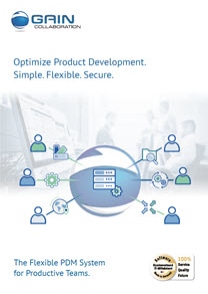
Develop PLM:
Trust in familiar building blocks
“PLM” is often discussed as the ultimate corporate goal. Is this true for every company? What is the actual benefit of PLM? And what does it take to profit from PLM? What does it look like in practice? Where and how does it make the most sense to start?
Questions & Answers
Around PLM
- What is PLM?
- Why PLM?
- What are the goals of PLM?
- Which areas are affected by PLM?
- What is a PLM system?
- Is there a PLM solution?
- Is PLM in any case the last stage of expansion?
Considerations before introducing PLM
- reliance on familiar things
- Existing building blocks and connections
- Analysis of existing modules or systems
Introduce PLM
What is PLM?
PLM stands for Product Lifecycle Management. What is meant is the management of product life cycles.
Why PLM?
By monitoring the entire product life cycle, companies hope to gain a better overview of all processes in the life cycle of a product. This includes, for example, initial design studies, production planning, economic aspects or even disposal or decommissioning.
What are the goals of PLM?
The goals can be …
- the shortening of the cycle in certain sub-areas
- optimise the efficiency of production
- the reduction of costs
- the elimination of redundant data entry in the company
Important in terms of goals: Prior to the introduction of , the objectives should be clearly agreed at management level: What is to become, what does it bring to the company and who uses and interprets results?
Which areas are affected?
In principle, all areas are affected that are involved in any way in the development of a product. For example …
- Construction (CAD)
- Calculation (CAE)
- Production planning and control (PPS)
- Sales (planning, sales, logistics)
- Services such as support or product replacement
- Disposal or recycling
What is a PLM system?
If the entire aforementioned sub-areas of the product life cycle are to be monitored, software is required that ultimately constitutes a PLM system.
Due to its complexity, such a system represents a conceptual approach rather than a self-contained, homogeneous IT solution. In this respect, a PLM system usually consists of several systems that are interconnected:
- ERP systems that enable business management evaluations.
- PDM systems with CAD, ECAD or CAM connections.
- A data management system (DMS) is integrated into an ERP system.
- Many an ERP system covers production planning.
Is there a PLM solution?
Although some manufacturers declare their software product as a singular “PLM system”, the providers of a self-contained overall system can be counted on a few fingers worldwide. Moreover, these solutions are very costly and not really satisfactory for all areas. Oversized or unsuitable for the middle class.
Is PLM in any case the last stage of expansion?
The combination of different systems can bring interesting, profitable information to light. If these are observed and evaluated at management level. Sometimes practice proves that a system was envisaged at the outset which, once implemented, is only partially respected. Or that goals were not clearly and comprehensively formulated in advance.
Considerations before the introduction
reliance on familiar things
At GAIN Software, we believe in trusting the familiar.
This is because many companies have already been using ERP and also PDM for many years. Thus, the employees of various departments have been able to gain a great deal of experience over the past 10 to 15 years. And therefore today know very well what they want and what not.
Already existing PLM modules and connections
In most cases, modules and thus also PLM processes are already available in the company and are fully or partially networked. Small-scale, workable approaches that are usually worth building on. Examples:
Parts of a data management system (DMS) are already integrated in the ERP system (software solution for resource planning). Still others in a PDM system.
Often an existing CRM system is already connected to the ERP solution as a communication platform.
And a PDM system takes care of the administration and control of CAD, ECAD, CAM and other documents.
Analysis of existing modules or systems
Perhaps some systems in companies already have a few years under their belt.
However, existing systems and processes should first be analyzed. Questions you should ask yourself before integrating (examples):
- Are the company’s own processes represented sufficiently or as desired in the systems?
- Does the PDM system fit into the overall landscape or can it only be used for design?
- Which ERP system is available and can it be linked to other systems?
- Can existing systems be optimized?
Or will new systems ultimately have to be introduced and built?
Introduce PLM
The phases of an introduction
The phases are based on existing building blocks. And here, first of all, the PDM module. Is it already integrated into the house? Can this PDM system be adapted for company processes and the coupling to other systems (ERP, DMS, etc.)?
Interfaces between the individual components are the first prerequisite for being able to network them at all.
Questions before the introduction
- Is a PDM system available and networked throughout the company?
- Does an existing ERP system offer appropriate interfaces?
- Is a DMS already implemented? Which areas can be linked to the ERP system and which to the PDM system?
- Can the DMS communicate with PDM and ERP?
- Does the introduction refer to a company or a group?
- Do multiple organizations need to be coupled?
- Should replication be considered?
Konkret: Die ersten Stufen Richtung PLM-System
- Anpassen des PDM-Systems an die Belange von Konstruktion, ECAD und CAM.
- Definieren der Kopplung von ERP zu PDM; Festlegen der Form der Datenübertragung vom PDM zum ERP.
- Automatisierung der Artikelanlage im PDM-System, um diese für die Übertragung an das ERP-System aufzuarbeiten.
- PDM-System für die Kopplung zum ERP anpassen (Datenbankfelder, Artikelverwaltung, Stücklistenkonfiguration, Nebendokumente).
- ERP-System für die Übernahme von Daten aus dem PDM-System vorbereiten. Prüfen des ERP-Systems auf Revisionsmöglichkeit.
- Prüfen, ob Artikelstammdaten aus dem ERP-System in das PDM-System übertragen werden müssen? Dies, um beispielsweise Stücklisten im PDM mit Artikelstammdaten zu ergänzen.
- Ist eine bidirektionale Kopplung notwendig, um beispielsweise im PDM-System einen Lagerbestand abrufen zu können? Dann muss das ERP hierfür die Schnittstelle innehaben.
- In ähnlicher Weise, jedoch mit weniger Umfang, muss die Kopplung zu einem DMS-System erfolgen, falls vorhanden. Auf ein gesondertes DMS System kann eventuell verzichtet werden, sofern das PDM- und das ERP-System diese Daten aufnehmen und verwalten kann.
PLM in Fluss bringen:
ERP und PDM verheiraten …
Your 1st step to GAIN Collaboration. Order a free demo:
Or do you have any questions
to GAIN Collaboration?
Please contact us: +49 521 967 613 – 0






